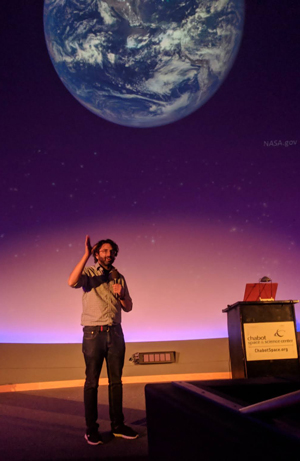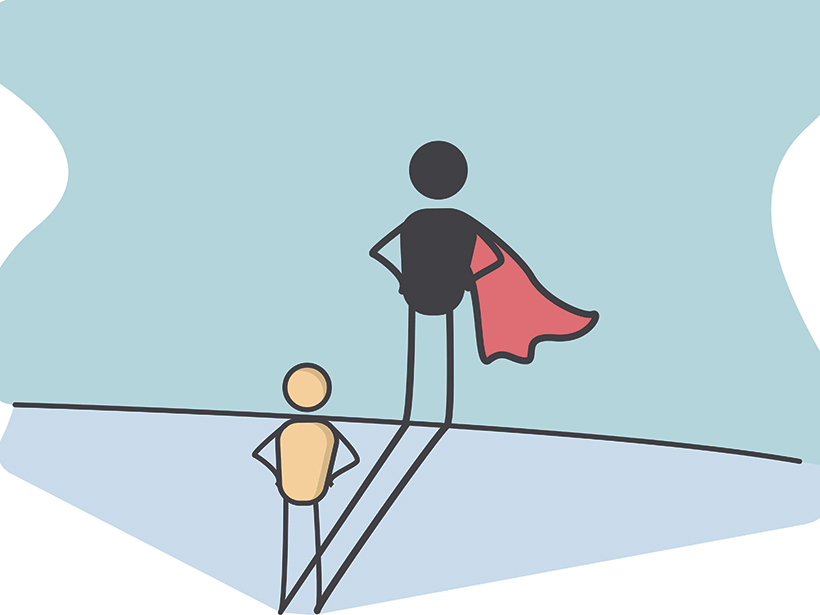We are two scientists who care strongly about communicating the value and excitement of science. One of us has a current interest in connecting with the general public, the other with policy makers. Despite these similarities, we have different personalities. Yet the necessary skills to make an impact in either area of interest overlap.
Through the Voices for Science program at AGU, we recently met 28 other like-minded Earth and space scientists committed to #scicomm. This group converged on Washington, D. C., in April for a 2-day skills-building workshop in which we learned from each other and from professionals, pooling our shared our experiences. Those in the policy track also got immediate hands-on experience by engaging congressional staffers on the second day.
The goal of the Voices for Science program, which began this year, is to support scientists who commit themselves to doing outreach activities for a year. By making AGU staff available and creating a network among us participants, the program makes science communication feel less like a solitary endeavor.
That and the release of a new Avengers movie around the time of our workshop, plus the passion of everyone involved, made us feel like avengers ourselves. By day, we hide our capes while writing proposals, running simulations, and performing laboratory experiments. But at night, we deploy as voices to try and do some good in front of audiences nationwide.
The goal of this article is to illustrate how Voices for Science, with its communication and policy tracks, helped us both in our respective communication strategies and education. Our hope is that this account of our experiences will encourage those of you reading who are also scientists to participate in the program next year. Here are our stories.
Sanjoy: Sharer of Emotions
“I am Sanjoy, reader of rocks, weigher of air, and inquisitor to water.”
I am Sanjoy, reader of rocks, weigher of air, and inquisitor to water. I am an astrobiologist who is 8 years post-Ph.D. and feel experienced in science communication. I consider myself outgoing. I am on the communication track.
Prior to the Voices workshop, I was already scheduled to give a public talk in San Francisco, Calif., as part of Astronomy on Tap, a loose-knit series of free lectures given by professional astronomers in bars across this country and a few others. Before attending Voices, I had given some thought to how I wanted to structure my talk, yet spending 2 days with my fellow science avengers completely reshaped my plan.
I had read Randy Olson’s book Don’t Be Such a Scientist while in graduate school and knew the importance of sharing a story. But it was at Voices where I realized the power of sharing emotions as well. A fellow participant shared a story about taking her son to a cabin that she herself had been taken to as a child but that now is at risk from environmental change. I realized during the discussion following her story that what had absorbed me most were the emotions she had conveyed. I committed then to involving my audience in my presentations as much as possible.
Breaker of Ice

An outreach presentation that I’ve enjoyed giving is on exoplanets and how the geological record of ancient Earth is helping us envision what an inhabited world other than our modern Earth could look like. Typically, I would show a slide or two describing ancient Earth, prior to discussing exoplanet habitability. But that was before Voices.
At Astronomy on Tap, I began my talk by asking the audience to take a deep breath with me and to reflect on how good such a deep breath feels. This exercise broke the ice: I was no longer an unknown entity at the podium who was about to pontificate unidirectionally about science but was someone they were sharing an activity with and therefore someone who’d gone suddenly from an outsider to a part of their in-group. Research shows that this transformation improves trust.
Then I took my audience with me on a journey to experience ancient Earth as if we were standing together on the surface of that strange, long-ago planet, with an artist’s rendering of the Archean era as my background slide. “Don’t take a breath!” I told them. “You will die.” (This line was particularly effective when I gave a version of this talk to middle schoolers. Several put their hands over their mouths.)
Builder of Trust
In the current political climate, trust between scientists and the public seems to have eroded. Telling an audience what to think is not an effective strategy. Audience members want to reach their own conclusions. So building trust through empathy and enabling curiosity is how we reconnect. Science communication today must be inclusive of who we are as communicators for us to be trusted to foster critical thinking about our world and the universe beyond.
As I was leaving Astronomy on Tap, the person selling tickets at the venue came up to me. She told me how “awesome” my talk was and was surprised that she could follow it. “You talked to humans, not to a bunch of astronomers!” I’d revealed my cape!
Meredith: Inspired Introvert
“I am Meredith, modeler of atmospheric organic gases, tamer of MATLAB, and aficionado of sleep.”
I am Meredith, modeler of atmospheric organic gases, tamer of MATLAB, and aficionado of sleep. I am a Ph.D. student, and I pretty much avoid communicating person to person with strangers about science or anything else. I consider myself an introvert. I am on the policy track.
To clarify: I’m not just your everyday introvert; I consider myself an extreme introvert—like, far along the introvert spectrum. If a pizza place doesn’t have online ordering, I don’t order from them. I recently spent 48 hours without any human contact and didn’t even realize it until the next day when someone asked me what I did over the weekend.
Do you wonder how I could have even considered Voices? Well, I assumed that at first I would be able to do most of my communicating via email, then slowly work my way up to actually talking to policy makers.
“I’d never spoken to a Congress member or his or her staff before, and I was about to meet with six in 1 day.”
Receiving an email 10 days before the workshop saying that we would be doing congressional visits even during the orientation had me more than a little nervous. Over the next few hours, I shared my anxiety with multiple office mates, friends, and even my parents. I’d never spoken to a Congress member or his or her staff before, and I was about to meet with six in 1 day. I definitely did not think I was ready.
A week and a half later, I was in D. C. for the orientation event, still feeling wildly unprepared for the impending adventure. I went to the first day of the workshop expecting a lot of presentations and a lot of myself feeling uncomfortable. I was pleasantly surprised by how encouraging and excited everyone was. The AGU leaders of the event really made sure everyone was prepared and knew they had their support, which really helped to subdue my nerves.
Enjoyer of “Team PA”

I spent a good portion of the orientation’s first day with my fellow Voices in “Team PA,” the group going the next day to offices of some of the Congress members from Pennsylvania, my home state. Everyone in the group besides me was a veteran congressional visitor.
Surprisingly, I immediately felt comfortable around them and thoroughly enjoyed working with them. This was entirely to the team’s credit, as they were all very encouraging with their praise and criticism during our practice visits. It was an environment where I felt that despite these people having been introduced to me mere moments ago, they really wanted me to succeed.
The next day we visited the offices of four representatives and two senators. In each, I told my story, speaking about my research and the research my group was doing and how totally cool it all is! I explained that I could do my research because of federal funding agencies. I talked about how lucky I was to be living and doing research in Pittsburgh, the city that I love and in which I was born. In my humble opinion, I think I did pretty well.
Superstar with Passion
“It didn’t matter how nervous I was (or how close I was to throwing my notes at my team to distract them as I ran away); I could be a superstar.”
In fact, one of the AGU staff members said that I was a “superstar.” Although that may be going a little too far, who am I to argue? I discovered that if I was comfortable enough with what I was talking about and passionate about the “ask” I was communicating for (the legislation or funding I was urging the congressperson to support), it didn’t matter how nervous I was (or how close I was to throwing my notes at my team to distract them as I ran away); I could be a superstar.
So if you are passionate about a scientific issue and are thinking of doing congressional visits but, like me, you also find your social battery drained after saying hi to one stranger, go for it! I revealed my cape, and you might too (#showyourcape).
—Sanjoy Som (email: [email protected]; @sanjoymarcel), Blue Marble Space Institute of Science, Seattle, Wash.; and Meredith Schervish, Department of Chemistry and Center for Atmospheric Particle Studies, Carnegie Mellon University, Pittsburgh, Pa.
Citation:
Som, S.,Schervish, M. (2018), What’s your superpower? Science communication, Eos, 99, https://doi.org/10.1029/2018EO105719. Published on 27 September 2018.
Text © 2018. The authors. CC BY 3.0
Except where otherwise noted, images are subject to copyright. Any reuse without express permission from the copyright owner is prohibited.

